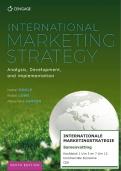INTERNATIONALE
MARKETINGSTRATEGIE
Samenvatting
Hoofdstuk 1 t/m 5 en 7 t/m 12
Commerciële Economie
CE8
,INHOUDSOPGAVE
1 AN INTRODUCTION TO INTERNATIONAL MARKETING .......................................... 3
2 THE WORLD TRADING ENVIRONMENT .................................................................. 6
3 SOCIAL AND CULTURAL CONSIDERATIONS IN INTERNATIONAL MARKETING ...... 9
4 INTERNATIONAL MARKETING RESEARCH AND OPPORTUNITY ANALYSIS .......... 12
5 INTERNATIONAL NICHE MARKETING STRATEGIES FOR SMALL- AND MEDIUM-
SIZED ENTERPRISES .......................................................................................... 15
6 GLOBAL STRATEGIES.......................................................................................... 19
7 MARKET ENTRY STRATEGIES .............................................................................. 22
8 INTERNATIONAL PRODUCT AND SERVICE MANAGEMENT ................................... 24
9 INTERNATIONAL COMMUNICATIONS ................................................................. 27
10 THE MANAGEMENT OF INTERNATIONAL DISTRIBUTION AND LOGISTICS .......... 29
11 PRICING FOR INTERNATIONAL MARKETS .......................................................... 32
12 STRATEGIC PLANNING IN TECHNOLOGY-DRIVEN INTERNATIONAL MARKETS ... 36
2
, 1 AN INTRODUCTION TO INTERNATIONAL
PART I
MARKETING
International trade: is the exchange of capital, goods and services
across international borders or territories. It refers to export of goods and
services by a firm to a foreign based buyer (importer). In most countries,
ANALYSIS
it represents a significant share of gross domestic product.
World Trade Organization (WTO): deals with the rules of trade
between nations at a global or near-global level
Global youth culture: contemporary 15-24-years-old combining local
and international culture and identities through technology and social
media
What is marketing? à management process responsible for identifying,
anticipating and satisfying customer requirements profitably, marketing
involves:
- Focusing on needs and wants of customers
- Identifying the best method of satisfying those needs and wants
- Orienting the company towards the process to providing that
satisfaction
- Meeting organizational objectives
PESTLE analysis: studies the key external
factors that influence an organization
- Political
§ Operational restrictions: exchange
controls, employment policies,
insistence on locally shared ownership
and particular product requirements
§ Discriminatory restrictions: tend
to impose on purely foreign firms and
sometimes only firms form a
particular country
§ Physical actions: actions are direct
government interventions such as
confiscations without any payment of
indemnity, nationalization or even
damage to property and war
- Economic
§ Gross national income (GNI): national income plus capital
consumption allowance
§ Gross national income per capita (GNIpc): GNI divided by the
country’s population
§ Least developed economies: name given to countries which,
according to the United Nations, exhibit the lowest indicators of
socio-economic development, with the lowest human development
index ratings of all countries in the world
- Social/cultural
§ Cultural paradoxes: describes the cultural sensitivities in a
market where there is evidence both of the westernization of tastes
and the assertion of ethnic, religious and cultural differences
3
, § European Union (EU): international organization of European
countries formed after WWll to reduce trade barriers and increase
cooperating among its members
§ Piracy: contemporary issue covering a range of concerns including
security for shipping, brand and product piracy in form of forgery
and fakes, copyright infringements and intellectual property rights
and pirated software and online streaming
- Technological
§ Emerging economies: nations with social or business activity in
the process or rapid growth and industrialization
- Legal
§ Local domestic law: different in every country
§ International law: issues include piracy, treaties, patents, etc.
§ Domestic laws in the home country: export controls, plus duty
to abide by national laws in all activities
- Environment/Sustainability
Different levels of international marketing (increasing complexity and level
of involvement in international marketplace):
1. Domestic/Export marketing: marketing of goods/services across
national boundaries, without adaptations to goods/services (Auping)
2. International marketing: marketing activities in more than one
country, control of marketing activities from outside the country where
the product will be sold (KLM)
3. Global marketing: process of conceptualizing and them conveying a
final product/service worldwide with the hopes of reaching the
international marketing community (Booking.com)
Internationalization: method of adapting an organization’s operations
to foreign environments, theories:
- Economic model: motivated by transaction costs (Volvo)
- Behavioral model (Uppsala): motivated by culture, religions and
geography (Doppelmayer Ski-lift)
- Network or relationship model: motivated by long term
relationships (ASML)
- Born global model: motivated by global customers (AIRBNB)
Differences between international and domestic marketing:
1. Culture: often diverse and multicultural markets
2. Markets: widespread and sometimes fragmented
3. Data: difficult to obtain and often expensive
4. Politics: regimes vary in stability, political risk becomes an important
variable
5. Governments: can be a strong influence in regulation importers and
foreign business ventures
6. Economies: varying levels of development and varying and
sometimes unstable currencies
7. Finance: many differing finance systems and regulatory bodies
8. Stakeholders: commercial, home country and host country
9. Business: diverse rules, culturally influenced
10.Control: difficult to control and coordinate across markets
4






